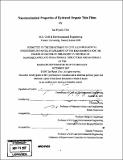| dc.contributor.advisor | Christine Ortiz. | en_US |
| dc.contributor.author | Choi, Jae Hyeok | en_US |
| dc.contributor.other | Massachusetts Institute of Technology. Dept. of Civil and Environmental Engineering. | en_US |
| dc.date.accessioned | 2009-03-20T19:55:58Z | |
| dc.date.available | 2009-03-20T19:55:58Z | |
| dc.date.copyright | 2007 | en_US |
| dc.date.issued | 2007 | en_US |
| dc.identifier.uri | http://dspace.mit.edu/handle/1721.1/42984 | en_US |
| dc.identifier.uri | http://hdl.handle.net/1721.1/42984 | |
| dc.description | Thesis (Ph. D.)--Massachusetts Institute of Technology, Dept. of Civil and Environmental Engineering, 2007. | en_US |
| dc.description | Includes bibliographical references (leaves 167-171). | en_US |
| dc.description.abstract | Hydrated organic thin films are biological or synthetic molecularly thin coatings which impart a particular functionality to an underlying substrate and which have discrete water molecules associated with them. Such films exist in biology (e.g. cell membrane lipid bilayers) and have a broad array of potential engineering applications (e.g. biological implant and sensor surfaces, marine antifouling paints etc.). This doctoral thesis focuses on two important classes of hydrated organic thin films that were prepared and studied in vitro. The first model system was an oligo(ethylene oxide)-based self-assembling monolayer (OEO-SAM) which is a synthetic material that is known to exhibit exceptional resistance to nonspecific protein adsorption and, hence, it is a viable candidate for producing implant surfaces with improved biocompatibility. The second model system was the biologically relevant phosphorylcholine(PC)-supported lipid layer which mimics the structure of the cell membrane. The objective of this doctoral thesis was to quantify the functional form of the net surface interaction (force versus separation distance, F(D)), as well as the contact mechanical properties (e.g. elasticity, plasticity, fracture) of these two model systems under different solution conditions, in order to formulate a hypothesis for the molecular origins of the dominant interactions and furthermore, to gain a mechanistic understanding of their in vivo function and performance. For the OEO-SAMs, F(D) was found to exhibit the maximum monotonic repulsive functional form for intermediate surface packing densities (-70%) on loading (approach) and negligible adhesion (Fadhesion<0.3nN) on unloading (retract). Both were attributed to an electrostatic component arising from a dipole induced effective surface charge, as well as a nm-thick hydrated water layer. | en_US |
| dc.description.abstract | (cont.) For the PC lipid layers, the effect of length scale on the yield threshold force, Fy, was studied by varying the probe tip end radius, Rtip, used for the surface force measurements. Fy decreased by 20x (Force/Radius) as Rtip increased from 30 nm to 80 nm, presumably due to the fact that the contact area possessed an increased density of molecular-level defects, thereby causing stress concentrations and a reduction in mechanical stability of the layer. | en_US |
| dc.description.statementofresponsibility | by Jae Hyeok Choi. | en_US |
| dc.format.extent | 171 leaves | en_US |
| dc.language.iso | eng | en_US |
| dc.publisher | Massachusetts Institute of Technology | en_US |
| dc.rights | M.I.T. theses are protected by
copyright. They may be viewed from this source for any purpose, but
reproduction or distribution in any format is prohibited without written
permission. See provided URL for inquiries about permission. | en_US |
| dc.rights.uri | http://dspace.mit.edu/handle/1721.1/42984 | en_US |
| dc.rights.uri | http://dspace.mit.edu/handle/1721.1/7582 | en_US |
| dc.subject | Civil and Environmental Engineering. | en_US |
| dc.title | Nanomechanical properties of hydrated organic thin films | en_US |
| dc.type | Thesis | en_US |
| dc.description.degree | Ph.D. | en_US |
| dc.contributor.department | Massachusetts Institute of Technology. Department of Civil and Environmental Engineering | |
| dc.identifier.oclc | 230938750 | en_US |
